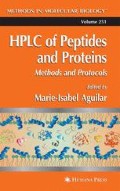Abstract
Immunization with a foreign antigen causes B cells of the immune system to produce antibodies of exquisite specificity toward the challenging antigen. This specific reactivity has made antibodies an essential tool for the detection and purification of protein in all fields of biological research. IgG is the most predominant class of serum antibody and is an integral part of many applications within the laboratory. The need to purify monoclonal or polyclonal antibodies is largely determined by the intended application of the antibody. Unpurified antibody is well suited to use in indirect flow cytometry assays, most enzyme-linked immunosorbent assays (ELISAs), for cytotoxicity assays or Western blot analyses. Purified antibody must be used, however, when accurate concentrations are required, chemical modifications such as labeling with fluorescent or radioactive probes are needed, when fragmentation of the antibody is required for binding or crystallization analysis or when antibody is directly coupled to a matrix for immunoaffinity chromatography.
Access this chapter
Tax calculation will be finalised at checkout
Purchases are for personal use only
References
Fanger, M.W. and Smyth, D.G. (1972) The oligosaccharide units of rabbit immunoglobulin G. Asymmetric attachment of C2-oligosaccharide. Biochem J. 127, 767–74.
Mage, M.G. (1980) Preparation of Fab fragments from IgGs of different animal species. Methods Enzymol. 70, 142–50.
Goding, J.W. (1978) Use of staphylococcal protein A as an immunological reagent. J. Immunol. Methods 20, 241–253.
Lindmark, R., Thoren-Tolling, K., and Sjoquist, J. (1983) Binding of immunoglobulin to protein A and immunoglobulin levels in mammalian sera. J. Immunol. Methods 62, 1–13.
Akerstrom, B. and Bjorck, L. (1986) A physicochemical study of protein G, a molecule with unique immunoglobulin G-binding properties. J. Biol. Chem. 261, 10,240–10,247.
Akerstrom, B., Brodin, T., Reis, K., and Bjorck, L. (1986) Protein G: a powerful tool for binding and detection of monoclonal and polyclonal antibodies. J. Immunol. 135, 2589–2592.ß
Author information
Authors and Affiliations
Editor information
Editors and Affiliations
Rights and permissions
Copyright information
© 2004 Humana Press Inc.
About this protocol
Cite this protocol
Powell, M.S., Wines, B.D. (2004). IgG Purification. In: Aguilar, MI. (eds) HPLC of Peptides and Proteins. Methods in Molecular Biology™, vol 251. Springer, Totowa, NJ. https://doi.org/10.1385/1-59259-742-4:341
Download citation
DOI: https://doi.org/10.1385/1-59259-742-4:341
Publisher Name: Springer, Totowa, NJ
Print ISBN: 978-0-89603-977-3
Online ISBN: 978-1-59259-742-0
eBook Packages: Springer Protocols

